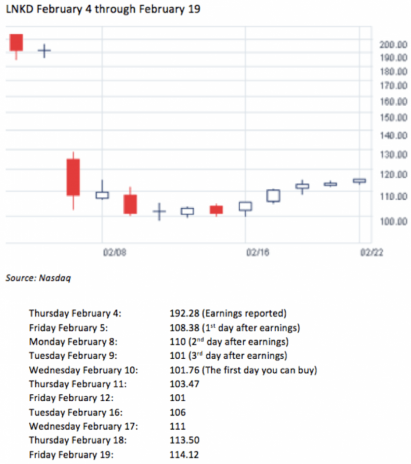The earnings season misses and stock blowups have already started.
Last week Philip Morris (PM) dropped 15%, Skechers (SKX) lost 28% and Atlassian (TEAM) fell 7%. What should you do if a stock drops dramatically on earnings? Should you buy the dip? The rule I learned on the trading floor is that you must wait at least three days before even thinking about buying the stock.
I began my career on the floor of the Chicago Board of Options Exchange (CBOE) in 1999, straight out of college. For a year, I stood next to two options trading legends, soaking up all of their wisdom as their clerk. That year, the market ripped higher as virtually every dot-com stock exploded higher day after day. I learned a great deal during that bull run.
[text_ad]
Here is a picture of a younger me (with more hair) in my trading pit on the CBOE.
Soon after I became a trader myself, the Nasdaq fell apart. The dot-com bubble burst, and valuations were reset for virtually the entire stock market. I learned even more during those bearish years than during the bull market years!
One rule that I took away from the bear years is about stocks that have taken a big dive.
The old trading rule that was hammered into my brain by my two trading legend mentors was this:
If a stock takes a big fall, whether it’s on earnings or some other news event, you MUST wait at least three trading days before even thinking about putting on a bullish position.
The rationale behind The Three-Day Rule is that if a large hedge fund or institution owns millions of shares of a stock, it won’t be able to sell out of its entire position in a day or two without causing the stock to fall.
My LinkedIn (LNKD) Earnings Season Example
Instead, the institution will parcel out its sales over a couple of days, so they don’t depress the stock and can sell at better prices. For example, let’s take a look at LinkedIn (LNKD), which fell from 192 to 108 in one day last February 5 on a disappointing earnings release. That was a staggering fall! The next day, the downgrades came pouring in from the brokerage houses (thanks for the downgrades after the fall!).
Based on the three-day trading rule, I wouldn’t have considered adding a bullish position on Friday, February 5, Monday, February 8 or Tuesday, February 9. But on Wednesday, February 10, according to the rule, I could begin to think about adding a bullish position.
Here were LNKD’s closing prices the day of its earnings report and the following days:
As you can see, selling pressure on LNKD remained in the three days after the big drop. Then, slowly but surely, the stock stabilized, and buyers began to take over.
As earnings season ramps this week with reports from Amazon (AMZN), Intel (INTC) and Starbucks (SBUX), there will inevitably be some big drops in stocks you have interest in buying. However, before buying the dip that first day, remember what all experienced floor traders refer to as The Three-Day Rule.
[author_ad]



